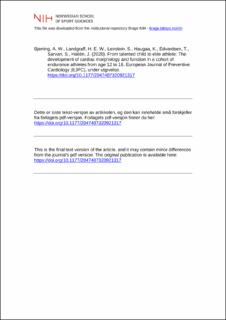| dc.contributor.author | Bjerring, Anders W. | |
| dc.contributor.author | Landgraff, Hege Wilson | |
| dc.contributor.author | Leirstein, Svein | |
| dc.contributor.author | Haugaa, Kristina | |
| dc.contributor.author | Edvardsen, Thor | |
| dc.contributor.author | Sarvari, Sebastian | |
| dc.contributor.author | Hallén, Jostein | |
| dc.date.accessioned | 2021-02-04T07:46:56Z | |
| dc.date.available | 2021-02-04T07:46:56Z | |
| dc.date.created | 2020-11-09T12:31:20Z | |
| dc.date.issued | 2020 | |
| dc.identifier.citation | European Journal of Preventive Cardiology (EJPC). 2020, under utgivelse. | en_US |
| dc.identifier.issn | 2047-4873 | |
| dc.identifier.uri | https://hdl.handle.net/11250/2726072 | |
| dc.description | I Brage finner du siste tekst-versjon av artikkelen, og den kan inneholde ubetydelige forskjeller fra forlagets pdf-versjon. Forlagets pdf-versjon finner du på journals.sagepub.com / In Brage you'll find the final text version of the article, and it may contain insignificant differences from the journal's pdf version. The definitive version is available at journals.sagepub.com | en_US |
| dc.description.abstract | Background: Adult athletes undergo cardiac adaptions in what is known as the “athlete’s heart”. Cardiac adaptations in young athletes have not been described in longitudinal studies but have previously been believed to be uniform in nature. Methods: Seventy-six cross-country skiers were assessed at age 12. Forty-eight (63%) completed the first follow-up at age 15 and 36 (47%) the second follow-up at age 18. Comprehensive exercise data were collected. Echocardiography with three-dimensional measurements and cardiopulmonary exercise testing were performed at all time points. The cohort was divided into active and former endurance athletes, with an eight hours of weekly endurance exercise cut-off at age 18. Results: The athletes underwent eccentric remodelling between ages 12 and 15, and concentric remodelling between ages 15 and 18. At age 18, the active endurance athletes had greater increases in inter-ventricular wall thickness (1.8 ± 1.4 Δmm vs 0.6 ± 1.0 Δmm, p < 0.05), left ventricular (LV) posterior wall thickness (1.6 ± 1.2 Δmm vs 0.8 ± 0.8 Δmm, p < 0.05), LV mass (63 ± 30 Δg vs 27 ± 21 Δg, p < 0.01), right ventricular (RV) end-diastolic area (3.4 ± 4.0 Δcm2 vs 0.6 ± 3.5Δ cm2, p < 0.05), RV end-systolic area (1.0 ± 2.3 Δcm2 vs –0.9 ± 2.0 Δcm2, p < 0.05) and left atrial volume (24 ± 21 ΔmL vs 6±10 ΔmL, p < 0.05) and had greater indexed maximal oxygen uptake (66.3 ± 7.4 mL/min/kg vs 57.1 ± 8.2 mL/min/kg, p < 0.01). There was no significant difference for LV volumes. Conclusion: This study finds a shift in the development of the young athlete’s heart. Between ages 12 and 15, the active endurance athletes underwent eccentric remodelling. This dynamic switched to concentric remodelling between ages 15 and 18. | en_US |
| dc.language.iso | eng | en_US |
| dc.subject | cardiomegaly | en_US |
| dc.subject | exercise-induced | en_US |
| dc.subject | echocardiography | en_US |
| dc.subject | three-dimensional | en_US |
| dc.subject | exercise test | en_US |
| dc.title | From talented child to elite athlete: The development of cardiac morphology and function in a cohort of endurance athletes from age 12 to 18 | en_US |
| dc.type | Peer reviewed | en_US |
| dc.type | Journal article | en_US |
| dc.description.version | acceptedVersion | en_US |
| dc.source.pagenumber | 8 | en_US |
| dc.source.journal | European Journal of Preventive Cardiology (EJPC) | en_US |
| dc.identifier.doi | 10.1177/2047487320921317 | |
| dc.identifier.cristin | 1846122 | |
| dc.description.localcode | Institutt for fysisk prestasjonsevne / Department of Physical Performance | en_US |
| cristin.ispublished | true | |
| cristin.fulltext | postprint | |
| cristin.qualitycode | 2 | |
